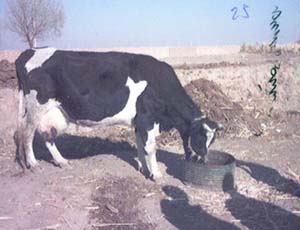| |
|
Southern Mongolian
Human Rights Information Center (SMHRIC) |
|
September 4, 2003, New York City |
|

|
|
Mongolian households who take
possession of a
|
|
mud house must borrow 5,000 RMB
from the
|
|
government to buy an imported
Australian
|
|
cow which
costs them almost 5,000 RMB
|
As an aggressive
gesture of loyalty to the Central Government, Inner Mongolian
authorities have launched a series of “west-to-east power
transmission” projects which have begun to force local Mongols
to abandon their ancestral pastoral lands. According to China’s
official news agency, Xinhua News, two of the largest power
plants in Inner Mongolia, Shuluun-Huh (Zhenglan in Chinese)
Power Plant and Daihai Power Plant, have recently started
construction at “top speed”.
A local Mongol from
Shuluun-Huh Banner has confirmed the accuracy of the Xinhua News
report and revealed how local Mongols are suffering because of
these massive projects.
On July 1, 2003, a
ground-breaking ceremony for a 1,200 kilowatt thermal power
plant was held in the heartland of northern Inner Mongolia, the
Shiliin-Gol League’s Shuluun-Huh Banner (Zhenglan qi in
Chinese). A 500 hectare area of grasslands will be forever lost
to the project. The facility will provide 900 kilowatts of
electricity daily to eastern China’s Beijing and Tianjin areas.
Shiliin-Gol League
is one of the most traditional and culturally well preserved
nomadic pastoral areas in Inner Mongolia and as such has become
a major target of the Central Government’s continuing series of
assimilation policies. These policies have been carried out
under slogans such as “environmental immigration”, “enclosure
and relocation”, “banning herding and pastoralism” and
“urbanization”. Previous reports had documented that by January
2002, 3,430 households with 14,691 Mongol herdsmen from this
area had been forcibly relocated. Now in the early stages of the
Shuluun-Huh Power Plant Project, the number of forcibly
displaced herdsmen is rising again. The local government of
Shand Som (Shang Du Su Mu in Chinese) has relocated the entire
population of Huang-Qi Gachaa (Huang Qi Dui in Chinese), a
village home to 84 households with 380 Mongolian herdsmen.
Houses and other infrastructure were demolished and even the
cemetery which is considered sacred to the Mongols has been dug
up and removed to make way for the power plant construction.
The government has
offered “compensation” to stifle the locals’ anger but with
three conditions. One, each household shall be paid 10,000 RMB
($1,100 US). For this payment, the displaced Mongols shall be
permanently barred from returning and shall individually and
personally bear the responsibility of finding some other
livelihood somewhere else. Two, households who do not choose
compensation shall receive a 5,000 RMB ($550US) mud house built
by the government. However, households who take possession of a
mud house must borrow 5,000 RMB from the government to buy an
imported Australian cow. Three, heads of households whose age is
60 or above shall not be eligible to borrow money from the
government.
Chinese authorities
have adopted a series of coercive policies forcing Mongol
herdsmen to give up their traditional nomadic life style, one
that’s disparagingly described as a “backward and primitive way
of life” in official news reports. Currently, the entire region
is engaged in carrying out the policy of “environmental
immigration”, “enclosure and relocation”, “banning herding and
pastoralism” and “urbanization” to ensure a “smooth” process in
the “western development” projects in Inner Mongolia. “This
project is not a simple human and animal population transfer. It
is a very well thought out ethnocidal process aimed at
eliminating the Mongolian population from the territory as soon
as possible” said an ethnic Mongolian scholar from Inner
Mongolia who asked not to be identified.
|





